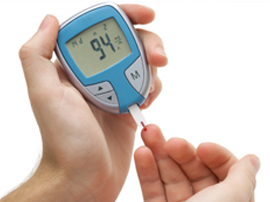There is an epidemic of obesity in America, and I see the signs in my office every day. But what many people don’t understand is that excess girth is not only uncomfortable, it also translates to a huge rise in diabetes, which, in turn, goes hand-in-hand with higher incidence of heart disease. Diabetes doubles the rate of heart disease in men and triples it in women. And the cause of his spiraling public health problem is 100 percent resolvable: It is entirely due to Americans’ tendency to eat too much and exercise too little. In today’s blog post, I will examine the relationship between obesity, diabetes, and heart health, and give you three easy steps to prevent and even reverse the vicious cycle of damage caused by these conditions.
The Epidemic Is Spreading
To understand the scope of the diabetes epidemic, you need only look at the numbers. According to the Centers for Disease Control and Prevention (CDC), 15 percent of Americans were obese in 1980. Today, that number is 30 percent.
And if you add in Americans who are not obese, but are just moderately overweight, the number jumps to an eye-popping 61 percent. The increase in diabetes even exceeds that level. In 1980, there were 5.5 million people with diabetes in the U.S. Today that number stands at 25 million — and it is still climbing.
But that’s not even the worst news. In 1980, only 5 percent of children were obese. That number has tripled, and the age at which people are becoming diabetic is getting younger and younger. These numbers threaten to wipe out all the progress our country has made in the fight against heart disease. It doesn’t have to be that way. Like heart disease, diabetes is preventable. Also like heart disease, it can be reversed. The key to beating diabetes is to drop that excess weight, once and for all. By the way, when using the term “diabetes,” I am referring to what is called Type 2 diabetes, formerly known as “adult onset” diabetes. This form of diabetes accounts for 90 percent of all cases, and it is this type of diabetes that fuels heart disease. Type 1, or juvenile diabetes, is an autoimmune disease in which the insulin-manufacturing abilities of the pancreas is gradually destroyed. This type of diabetes also can cause heart damage, but unfortunately it’s not preventable, and is much rarer.
Keeping your sugar in check can help to prevent diabetes
What Is Making us Obese?
Twenty years ago, the average bagel had 120 calories; today, it contains 350. Back then, a plate of spaghetti and three small meatballs had 590 calories. Today, if you order such a meal, it will be twice the size and twice the calories. The food industry certainly isn’t helping either. For instance, one fast food restaurant’s current advertising campaign urges Americans to add a late-night “fourth meal” to our diets. We’re in the midst of an obesity epidemic and we need to add another meal? Not a good idea.
But portions are only part of the problem. A consistently lazy lifestyle is also contributing to the spread of diabetes. According to a recent report by the CDC, fewer than two out of every 10 Americans get the recommended 150 minutes of moderate to vigorous physical activity each week. The report even found that 25 percent of Americans don’t exercise at all. This means no golf, gardening, or other leisurely physical activity. These people don’t even go for a walk around the block! If you are overweight, the likelihood that you will become diabetic increases so much. To put it into perspective- obesity even trumps genetics as a cause of diabetes.
Should You Be Tested for Diabetes? Eliminating belly fat is essential to preventing diabetes.
You should be tested for diabetes if you are over the age of 45 and you currently have one or more of the following risk factors:

- A history of cardiovascular disease
- Persistent inactivity
- Overweight or obese
- Immediate family with diabetes
- An ethnicity that is African American, Alaska Native, American Indian, Asian American, Hispanic/Latino or Pacific Islander
- Gave birth to a baby weighing more than 9 pounds or have been diagnosed with gestational diabetes, which is a temporary form that occurs during pregnancy
- High blood pressure
- High cholesterol or triglycerides (specifically having an HDL, or “good” cholesterol below 35 mg/dL, or a triglyceride level above 150 mg/dL
- Polycystic ovary syndrome, also called PCOS
- Have other conditions associated with insulin resistance, such as acanthosis nigricans, characterized by a dark, velvety rash around the neck or armpits
How to Beat Diabetes in Three Steps
Diabetes puts millions of people at risk of blindness, stroke, heart disease, and more. But, once again, it doesn’t have to be that way.In a study published a few years ago in the Archives of Internal Medicine, researchers asked 4,883
men and women 65 and older about lifestyle habits such as:
The subjects were then divided into low-risk and high-risk groups for diabetes, and were followed for 10 years. At the end of the research period, the scientists found that eliminating all five of these lifestyle risk factors would result in a whopping 90 percent reduction in the number of diabetes cases.
STEP 1: LOSE WEIGHT. Getting down to your ideal weight is a sure-fire way to beat diabetes. Even as you lose weight, you will see dramatic changes in your blood glucose levels and blood pressure — proof that you are fighting diabetes.
STEP 2: EAT TO PREVENT DIABETES. Fortunately, you don’t have to undergo bariatric surgery to lose weight; you can do it yourself with just your knife and fork. And you can do this the same way you can prevent and reverse heart disease— by following my recommendations to stick to a plant-based, whole foods diet. This means choosing your foods from around the perimeter of the supermarket, where the fruits, veggies, and dairy products are stocked, and avoiding the processed foods, which are located in the middle aisles.
STEP 3: EXERCISE DIABETES AWAY. How does exercise work on diabetes? When you exercise, your body uses insulin more efficiently. In fact, your body creates temporary insulin receptors, which can eventually result in helping you eliminate diabetes altogether.
Remember, diabetes is one of the most deadly diseases out there. But it’s also one of the most preventable. Whether you fall ill with diabetes or conquer it is entirely within your control. Losing weight, eating right, and exercising can make the difference between your being a victim and living a long, healthy life.
To Your OVERALL Health,
Dr. Chauncey W. Crandall

